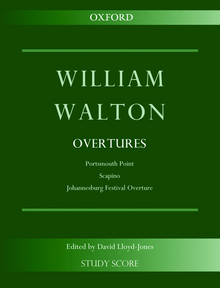Johannesburg Festival Overture

Johannesburg Festival Overture is a composition for orchestra by the English composer William Walton, commissioned to mark the seventieth anniversary of Johannesburg in 1956. It is a short, lively piece, fast-moving throughout.
Background
In 1956, to celebrate the seventieth anniversary of the founding of
Walton described the overture to his publisher as "a non-stop gallop ... slightly crazy, hilarious and vulgar".
First performances
Sargent conducted the
Score
The work is scored for three flutes (third doubling piccolo), two oboes, cor anglais, three clarinets in A, three bassoons (third doubling contrabassoon) – four horns in F, three trumpets in B-flat, three trombones, tuba – timpani, three or four percussion (side drum, cymbals, suspended cymbal, bass drum, xylophone, tambourine, triangle, tenor drum, maracas, rumba sticks, castanets, glockenspiel) – harp – strings.[11]
The work is a rondo, fast-paced throughout. Its first tempo marking is presto capriccio; after a very small ritardando the tempo becomes vivacissimo, which accelerates into a prestissimo. The key is D.[12]
Publication
Oxford University Press published an 84 page study score in 1958. The score, edited by David Lloyd-Jones, is included in the William Walton Edition, in volume 14, "Overtures".[11] Vilém Tauský arranged a reduced orchestra version in 1957.[13]
Recordings
The composer recorded the work with the Philharmonia Orchestra on 26 March 1957.[14] Later recordings:
| Orchestra | Conductor | Release date |
|---|---|---|
| New York Philharmonic | Andre Kostelanetz | 1961 |
| National Youth Orchestra of New Zealand | Ashley Heenan | 1967 |
| Royal Liverpool Philharmonic | Sir Charles Groves
|
1969 |
London Philharmonic
|
Bryden Thomson | 1991 |
| Radio-Sinfonieorchester Basel | Erich Schmid | 1996 |
English Northern Philharmonia
|
Paul Daniel | 1996 |
References
- ^ "Johannesburg Festival", Basutoland News, 17 July 1956, p. 2
- ^ Morrison, p. 130
- ^ a b Kennedy, p. 195
- ^ a b Lloyd, p. 229
- ^ Rycroft, David. "The Guitar Improvisations of Mwenda Jean Bosco", African Music, Vol. 2, No. 4 (1961), p. 81 (subscription required)
- ^ Louw, Johan L., and Johan K. Louw. "Notes and News", African Music, Vol. 1, No. 3, 1956, p. 73 (subscription required)
- ^ Lloyd, p. 218
- OCLC 1267975941
- ^ a b c Kennedy, p. 295
- ^ Durgin, Cyrus. "Boston Symphony Orchestra", The Boston Daily Globe, 16 March 1957, p. 10
- ^ a b "Johannesburg Festival Overture", Oxford University Press. Retrieved 14 March 2024
- ^ Howes, p. 116
- ^ "Johannesburg Festival Overture", Oxford University Press. Retrieved 14 March 2024
- ^ Kennedy, p. 324
Sources
- ISBN 978-0-19-315431-5.
- ISBN 978-0-19-816705-1.
- Lloyd, Stephen (2001). William Walton: Muse of Fire. Boydell Press. ISBN 978-0851158037.
- ISBN 978-0-57-121584-3.
External links: music videos
- Johannesburg Festival Overture - Walton (Full Orchestral Score Video) on YouTube. Video duration 7m 49s. Uploader Adam Schreiber Music, 2021.
- William Walton - Johannesburg Festival Overture (Bundesjugendorchester, Alexander Shelley) on YouTube. Video duration 8m 25s. Uploader EuroArtsChannel, 2021.
| Stage works |
|
|---|---|
| Orchestral music |
|
| Concertante | |
| Chamber music | |
| Film scores | |
| Other compositions |
|
| Collaborations | |
| Related articles | |
